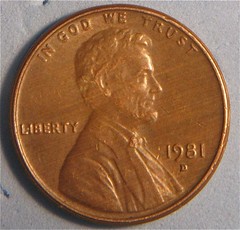
PREV ARTICLE
NEXT ARTICLE
FULL ISSUE
PREV FULL ISSUE
DAVE BOWERS ON WOODGRAIN COIN SURFACES
Dick Johnson and others wrote as recently as last year in The E-Sylum about "woodgrain" surfaces on coins. This week Rick Bagg asked Dave Bowers about it, and Dave copied me on his response. Here it is. The image is a 1981-D Woodgrain Lincoln Cent used to illustrate Dick Johnson's comments in the March 8, 2009 issue.
-Editor
Woodgrain is a visual effect that shows parallel streaking of toning, lighter alternating with darker areas. It seems to be most evident on Indian cents of the 1864 to 1870s era and also on some cents circa 1909-1914, but is also elsewhere, including on two-cent pieces. Bronze is an alloy of 95% copper and 5% tin and zinc. I suggest that tiny particles of tin or zinc, unmixed or partially mixes, survived in the bronze ingots used for cents. These ingots were rolled out into long, thin strips by a rolling machine that on each pass had the steel rollers ever more closely together. This had the effect of distending these tiny bits of tin/zinc. From these strips, circular planchets were cut. In time, as the bronze coins toned to brown, these tiny inclusions toned a slightly lighter hue producing the “woodgrain” effect. This is of very pleasing appearance. If I had a choice I would rather have a coin RB or BN with a woodgrain effect than one that is solid brown. The effect shows up best on RB [Red/Brown] coins. Ken Bressett adds: I have never given much thought to the ‘woodgrain' effect, but have always thought that it was very attractive and in the premium category. Dave has correctly identified it and how it occurs. The odd alloy probably has something to do with a not too careful mixture of basic metals and recycled coins that went into the melting pot.
To read the earlier E-Sylum article, see:
MORE ON WOODGRAIN COIN SURFACES
(www.coinbooks.org/esylum_v12n11a07.html)
The Numismatic Bibliomania Society is a non-profit organization promoting numismatic literature. See our web site at coinbooks.org. To submit items for publication in The E-Sylum, write to the Editor at this address: whomren@gmail.com To subscribe go to: https://my.binhost.com/lists/listinfo/esylum All Rights Reserved. NBS Home Page Contact the NBS webmaster 
|
